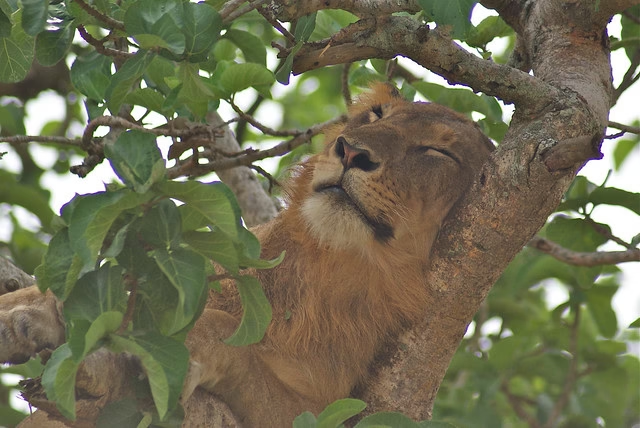Lions in Uganda-Lion safaris in Uganda-tree-climbing lions Uganda-Queen Elizabeth lions.

Lions, often called the “kings of the jungle,” are among the most iconic and sought-after wildlife species in Uganda.
These majestic predators symbolize strength, power, and the raw beauty of the African wilderness. Uganda is home to a healthy population of lions, found primarily in savannah landscapes across several national parks and reserves.
For wildlife enthusiasts, spotting a lion in its natural habitat is a thrilling and unforgettable experience.
Where to Find Lions in Uganda
Lions are found in a variety of protected areas in Uganda, with specific parks offering unique experiences to view them in the wild. Here are the top destinations:
1. Queen Elizabeth National Park
Queen Elizabeth National Park is the top destination for lion sightings in Uganda. The park is home to the famous tree-climbing lions of the Ishasha Sector, a rare behavior observed in only a few lion populations in Africa.
Where to Spot Them.
The Ishasha Sector for tree-climbing lions.
The Kasenyi Plains, where lions often hunt for prey like Uganda kobs and buffalo.
Seeing lions sprawled on fig tree branches, a behavior believed to help them avoid flies and enjoy cool breezes.
2. Murchison Falls National Park
Uganda’s largest national park offers vast savannahs where lions thrive.
Game drives on the Buligi game tracks or near the Delta Point often reveal lions stalking prey or lounging in the tall grasses.
Lions in this park are often seen alongside the breathtaking backdrop of the Nile River and the iconic Murchison Falls.
3. Kidepo Valley National Park
Known for its rugged beauty, Kidepo Valley National Park provides a serene and exclusive lion safari experience.
Lions are frequently seen in the Narus Valley and around the Kanangorok Hot Springs.
The park’s low tourist density ensures a more intimate and uncrowded lion-watching experience.
4. Pian Upe Wildlife Reserve
Pian Upe offers opportunities to see lions in a less commercialized setting. Though sightings are less frequent than in other parks, the reserve’s remoteness makes the experience rewarding.
Lion Behavior and Social Structure
Understanding lion behavior can enhance your chances of spotting and appreciating these magnificent creatures.
Social Animals
Lions are the only cats that live in groups, called prides, which typically consist of 10–15 individuals, including females, cubs, and a dominant male.
Hunting
Lions are apex predators that hunt cooperatively, often targeting herbivores like zebras, buffaloes, and antelopes. They usually hunt at night or during the early morning.
Territorial
Male lions are highly territorial and will fiercely protect their pride and territory from rival males.
Best Time to See Lions in Uganda
The dry seasons (June–September and December–February) are ideal for lion safaris. During these periods:
Vegetation is sparse, making lions easier to spot.
Prey congregates around water sources, increasing the likelihood of predator-prey interactions.
Challenges Facing Lions in Uganda
Lions in Uganda face several threats despite their status as apex predators:
Human-Wildlife Conflict
Lions occasionally prey on livestock, leading to retaliatory killings by farmers.
Habitat Loss:
Encroachment on protected areas reduces the available range for lions to hunt and roam.
Poaching:
While not directly targeted, lions are affected by the poaching of their prey, which reduces their food sources.
Disease:
Lions can contract diseases such as bovine tuberculosis, which can spread from domestic livestock.
Conservation Efforts for Lions in Uganda
Uganda is committed to protecting its lion population through several initiatives:
Protected Areas
Lions are safeguarded within national parks and reserves under the jurisdiction of the Uganda Wildlife Authority (UWA).
Human-wildlife conflict mitigation.
Conservation organizations work with communities near parks to implement measures such as predator-proof livestock enclosures and compensation for losses.
Research and Monitoring:
Ongoing studies track lion populations, assess threats, and develop conservation strategies.
Ecotourism:
Lion safaris contribute to local economies, encouraging communities to support conservation efforts.
Activities Involving Lions in Uganda
Game Drives


Early morning and late afternoon game drives in parks like Queen Elizabeth and Murchison Falls offer the best chances to see lions hunting or relaxing.
Boat Safaris
In Murchison Falls, lions can sometimes be spotted near the riverbanks during a Nile boat safari.
Photography
Uganda’s scenic landscapes and diverse wildlife provide incredible opportunities for capturing lions in their natural habitat.
Why Lions Are Special in Uganda
Lions play a critical role in maintaining the balance of ecosystems by regulating herbivore populations. Uganda’s diverse landscapes, from the savannahs of Queen Elizabeth to the remote valleys of Kidepo, offer unique and varied lion encounters.
Observing these powerful animals in the wild highlights the beauty and importance of conserving Uganda’s natural heritage.
Fun Facts About Lions
Male lions can sleep up to 20 hours a day, conserving energy for hunting and patrolling their territory.
A lion’s roar can be heard up to 8 kilometers (5 miles) away.
Female lions do most of the hunting in apride, but males often eat first.
Plan Your Lion Safari in Uganda
Uganda’s national parks and reserves provide incredible opportunities to observe lions in the wild.
Whether it’s the tree-climbing lions of Queen Elizabeth or the pride roaming the plains of Kidepo, every lion sighting in Uganda is a testament to the country’s commitment to wildlife conservation.

